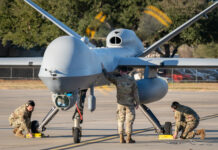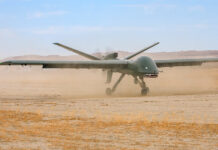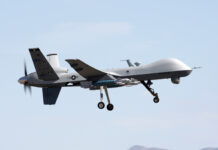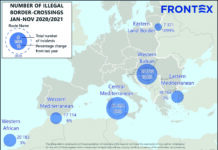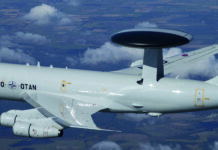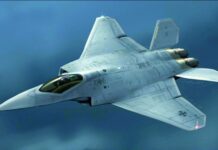Military operations over the last decade have highlighted how important it is to have Unmanned Aerial Vehicles (UAV) in the inventories of armed forces. Although UAVs are still one of the major requirements of European armed forces, the need to fill capability gaps resulting from years of low defence spending has somehow slowed down the procurement and development of UAVs in a field where Europe was already lagging behind.
Recent high and low intensity global conflicts have once again demonstrated the added value that UAVs offer armed forces. Compared with manned aircraft, UAVs are cheaper in terms of acquisition and operating costs, and safer due to the lack of personnel on board.

UAVs are also a useful means of collecting huge amounts of information in 4D scenarios (Dull, Deep, Dirty and Dangerous). They have already demonstrated their remarkable capabilities for ISTAR (Intelligence, Surveillance, Target Acquisition and Reconnaissance) and armed ISTAR missions. The improved situational awareness they bring has a positive impact on both mission planning (commanders gather more information) and the military operations themselves (as UAVs provide immediate air support to ground forces), making them an important force multiplier. The existence of three UAV classes (less than 150 kg, between 150 kg and 600 kg, over 600 kg) allows users to choose the most cost-effective solution for their operational requirements and budget. However, weight and size also tend to determine the technical features – such as maximum service ceiling and range – and are decisive for the choice of payloads on board. As a result, each class typically provides a different type of user support – operational, tactical and strategic. Compared with manned aircraft, MALE (Medium Altitude, Long Endurance) vehicles are the most powerful and cost-effective. Taking all this into account, most countries and the most powerful terrorist groups have decided to expand the use of these means, both armed and unarmed.
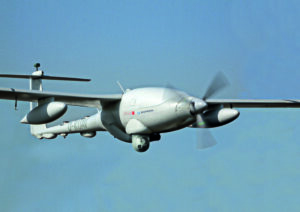
European countries follow this general procurement trend, with France, Italy, Germany and the UK being the main users and trendsetters in terms of operational requirements and development of cooperative technologies. European countries have gained relevant first-hand experience of UAVs in combat operations during the operations in Afghanistan, Iraq and Libya. UAVs operated by the US in the two Middle Eastern countries have allowed for acquiring relevant information and neutralising threats without putting troops on the ground at risk, a significant advantage due to the high number of IEDs (Improvised Explosive Devices) used in these operations. The military mission in Libya in 2011 confirmed the importance of UAV-carried ISR missions, and suggested that unmanned technologies would have been the best solution to fill the long-lasting capability gap in this domain, which first emerged in the 1990s during operations in the Balkans. It is important to recall here that the redeployment of US unmanned assets was necessary in Libya to support the missions led by European countries due to the lack of relevant ISR assets.
European countries have drawn two main lessons from these experiences: the advantages that UAVs bring, especially in operations carried in non-contested airspace, and the need to acquire their own UAV fleets to increase their independence from Washington.
Which UAV to Go for?

Almost a decade later, most European countries have UAVs in their inventory. Ideally, technologically advanced armed forces should have a diverse fleet of UAVs in their inventory, so that they are able to select those that best suit their operational scenarios on a case-by-case basis. However, UAVs weighing more than 150 kg are still a rather costly commodity, which limits their purchase in times of budgetary constraints. As a result, the lightest models are most common among European armies, navies and special units, while tactical and strategic vehicles (on which we will focus because of their greater operational effectiveness) are only used in a limited number of countries, particularly in armed versions. Now that the number of European users has increased, a divisive issue remains: the choice between domestic and Israeli and/or US off-the-shelf products. Most countries have opted for mixed solutions, which may even include leasing options (as is the case for France, Germany and Greece).
The issue of off-the-shelf procurement encompasses strategic, political and industrial considerations that are even more relevant in the case of armed UAVs (also known as UCAVs). For about a decade, the US has been the main exporter of these technologies and has imposed strong policy constraints on the procurement of military equipment. On the one hand, European countries are still the main users of the MALE drones produced by the US. For example, France, Italy, the Netherlands, Belgium (SKYGUARDIAN version), Spain and the UK are currently the only foreign users of MQ-9 REAPERs, with India being the first non-European buyer. Other allies of the US, such as Saudi Arabia and (perhaps) Turkey, were not allowed to buy it despite their formal requests.
However, flying American equipment can be a major obstacle for European countries. After Washington approved the sale of UCAVs in 2015 (in fact the possibility of arming MQ-9 REAPERs with AGM-114 HELLFIRE missiles), the UK and Italy were the only MQ-9 REAPER users to receive approval from the US Congress to arm their systems, with France following in 2017, several years later.In short, their military capabilities on the battlefield have been affected by political considerations abroad.
In other words, in order to become more independent from the US in terms of ISR capabilities, European countries procured products from the US, somehow increasing their dependence on Washington. As will be further analysed, it is difficult to find a balance between “buy European” and “buy American”.
Tactical UAVs
According to estimates, tactical UAVs – those weighing between 150 kg and 600 kg – account for 20% of the global UAV market today. More affordable and easier to operate than MALE UAVs, they represent a cost-efficient compromise for armed forces with limited participation in external operations and/or with budget constraints. But they are also a valid alternative in low-intensity operations for countries operating strategic UAVs as well.
When compared with larger models, tactical UAVs are easier to deploy in terms of logistics and can be operated by a land forces’ member rather than piloted by an air force operator. Their ability to gather relevant information in areas far from the battlefield is enabled by the array of available sensors – for example, electro optic/infrared (EO/IR) balls, laser designators, radars with Synthetic-Aperture Radar (SAR)/Ground Moving Target Indicator (GMTI) functions, and SIGnal INTelligence (SIGINT) sensors.

Between 2019 and 2020, France, Italy, the UK and Germany updated their tactical UAV fleets with the Safran PATROLLER, the Textron SHADOW V2, the Thales WATCHKEEPER, and the EMT LUNA NG, respectively. Future trends on tactical UAV requirements concern the procurement of unmanned helicopters (considered tactical UAVs according to their operational use) and the possibility to arm tactical UAVs.
VTOL Tactical UAVs
Growing numbers of European states have expressed their interest in acquiring VTOL (Vertical Take-Off and Landing) tactical UAVs despite their limited reliability in harsh conditions. Unmanned helicopters fit well on naval vessels thanks to their capabilities and their size. They are able to gather information across the maritime operational environment and are valuable alternatives to manned ISR missions, but are also deployed for manned SAR (Search and Rescue) and ASW (Anti-Submarine Warfare) operations, depending on their payload. Germany and France have launched dedicated procurement programmes in this field. The OCEAN 2020 programme (Open Cooperation for European mAritime awareNess) demonstrates that the willingness to further develop drones for naval use is in fact pan-European. Launched in 2019, the biggest EU-funded defence programme focusses on promoting joint aspects of maritime operations, including cooperation among different types of manned and unmanned assets, coordinated by command and control systems. A first exercise held in November 2019 involved Leonardo AWHERO and SW-4 SOLO.
Unveiled in 2018, AWHERO is a 200 kg class rotary wing UAS with an 85 kg payload, which can be used for both maritime and land operations, and can fly 6 hour-long missions.
Leonardo has been able to acquire highly relevant skills in this segment thanks to the purchase, in 2017, of IDS Sistemi Dinamici, an Italian company specialised in VTOL technologies. AWHERO is a sine qua non for the Italian Navy for integration on its vessels, but no official procurement procedure has yet been launched.
The SW-4 SOLO is an Optionally Piloted Helicopter (OPH) produced by Leonardo in Poland.
It weighs 1,800 kg, with a 450 kg payload, and can fly 6-hour long missions. The maiden flight, with no safety pilot, was concluded in February 2018. This model has been tested with the British Ministry of Defence as part of the Rotary Wing Unmanned Aerial System (RWAUS) Capability Concept Demonstration (CCD) since 2013. Since 2018, the SW-4 SOLO has been involved along with QinetiQ and Thales in the Royal Navy’s Maritime Autonomous Platform Exploitation (MAPLE) programme that aims to create an information architecture required to integrate a diverse mix of live unmanned systems into a common operating picture.
Leonardo’s UAVs are not the only European products available on the market. CAMCOPTER S-100, produced by the Austrian company Schiebel, is probably the model that has raised most interest among European countries. The Belgian, Norwegian, German, Italian and French navies have all tested this system, which has a 6-hour flight endurance, weighs 200 kg, and can carry a 34 kg payload. Italy was the first European country to operate this system. After a first test campaign in 2012, the Marina Militare and Schiebel signed a contract in 2014 for a one-year lease of one system (consisting of two UAVs) to better evaluate its performance. CAMCOPTER S-100s have been used on board LPD San Giusto to support humanitarian interventions within Operation Mare Nostrum (the Italian operation in place in the Mediterranean before the EU-led operations Triton and Eunavfor Med/Sophia).
In November 2019, the French Armament Procurement Agency (DGA) qualified the integration of the Schiebel CAMCOPTER S-100 UAV on board the Dixmude amphibious helicopter carrier (PHA), marking the first time in Europe that a rotary-wing UAV became fully operational and connected to the combat system of a warship. The Deutsche Marine, which carried out tests in 2008, was expected to buy six CAMCOPTER S-100s to be operated from K-130 class corvettes, but finally abandoned the procurement procedure in 2013. Berlin finally preferred the purchase of the V-200, produced by Saab’s subsidiary UMS Skeldar, in 2018. This modular UAV, with a 40 kg payload, can be equipped with VIDAR (Visual Detection and Ranging), which provides enhanced coverage compared with EO/IR systems. These UAVs have been operated by the Spanish Navy in anti-piracy operations since 2013 under a service provision agreement with the company.
As part of its drone system for the navy (Système de Drone Aérien pour la Marine, SDAM), the French Marine Nationale (MN) is seeking a tactical UAV to be deployed onboard the future FDI/AMIRAUX class frigates, with deliveries starting in 2025. MN requires an all-weather, 24/7 system, able to provide tactical situational awareness to the vessel on which it is embarked in any type of maritime operation. The desired features are a maximum 700 kg take-off weight with a 100 kg payload capacity, a 185 km operational range, with a speed of 186 km/h and a 15,000 ft. service ceiling. In summer 2019, MN conducted trials with an optionally piloted demonstrator of Airbus VSR700 rotary-wing tactical UAVs.
VSR700 has a 10-hour flight endurance and weighs 760 kg, with a 100 kg payload. The first prototype completed its first flight in November 2019 and trials of the first demonstrator are expected in 2021. Future trials will be made in collaboration with Naval Group, which participated in the design and development of the warship-integrated VTOL system, as well as in the UAV mission system.
Arming or Broadening Fleets
In addition to expanding existing fleets, the impact that tactical UAVs have on the battlefield will probably improve thanks to weaponry. Conflicts in Syria and Yemen have proven that armed tactical UAVs can be a significant force multiplier, even when equipped with improvised bombs. Therefore, for European countries, the main requirement (and technical challenge) is weapon miniaturisation, which would result in an optimal balance between lethality and weight.
In October 2019, during an audition at the Senate, the French Army Chief of Staff, General Thierry Burkhard, officially confirmed that Safran PATROLLERs will be armed. The French armed forces finally chose the Thales 68mm laser-guided rocket, which already equips the TIGER helicopter, over the air-launched version of MBDA’s MMP (Medium Range Missile).
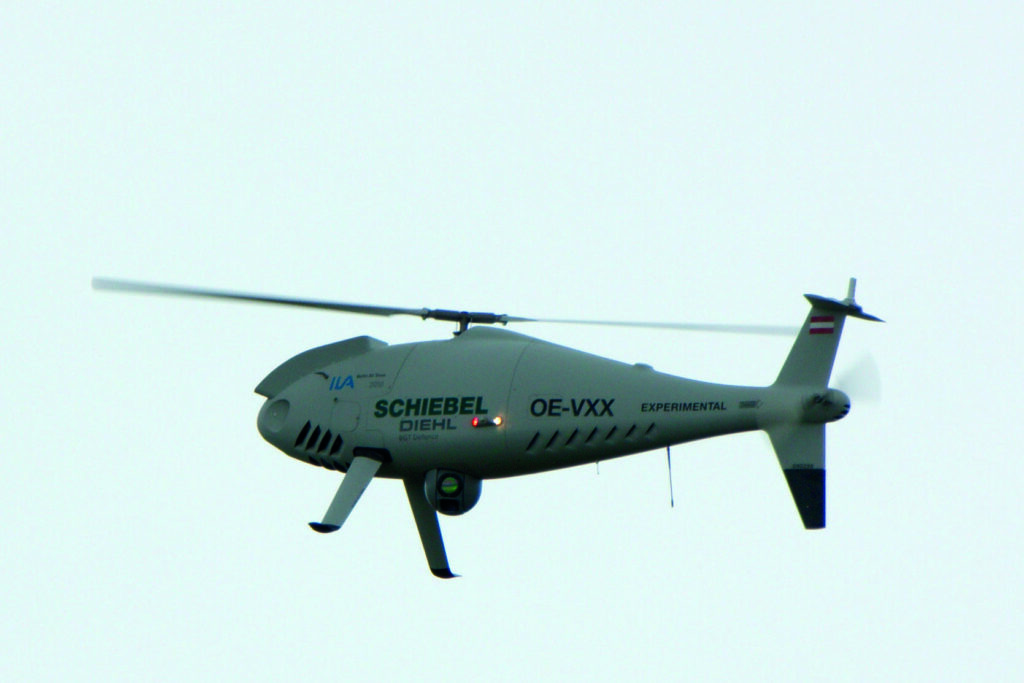
Cheaper and lighter than MMP, laser-guided rockets are well-suited for UAVs against targets of opportunity (pick-up trucks, snipers, and so forth) while on-station. The choice enhances French strategic independence in this segment, as the PATROLLER is mainly produced domestically (90% of components are French made).
Although Italy and UK have not considered this option, both the Textron SHADOW V2 and the Thales WATCHKEEPER can be armed. The first platform can carry Textron FURY lightweight guided weapons, while weapons for WATCHKEEPER have not yet been disclosed.
Providing an EU Response to MALE Requirements
European states have rapidly understood the benefits that pooling and sharing might bring to the development of future European MALE. Working on different national products to respond to similar operational requirements is not a cost-effective solution. Moreover, the limited number of assets each country is expected to buy does not allow for economies of scale. After a decade of R&D on technological demonstrators (for example, nEUROn), two joint programmes could succeed in the next decade. The MALE RPAS programme (previously known as MALE2020) is expected to provide Italy, Germany, France and Spain with armed ISTAR capabilities by 2025 – if a deal on the next phase is reached shortly.
Also, France and the UK agreed on developing a joint Future Combat Air System (FCAS) in 2016, but the programme stalled due to Brexit-related issues.
Above all, it is the issue of common requirements that endangers the MALE RPAS programme. According to the full-size mock-up unveiled at the ILA Berlin Air Show 2018, the MALE RPAS would be much larger than the MQ-9 REAPER and would feature a twin-pusher propulsion and a single electro-optical/infrared (EO/IR) sensor. These features seem closer to German requirements, which are mainly focussed on the need to fly in non-segregated air space, also considering the country’s posture towards international operations, than to French ones. Indeed, Paris’ requirement is a jet-powered model with EW pods and some stealth features, a sort of light UCAV that can fully replace the MQ-9 REAPER. Two main questions are affecting the programme, which is not advancing at the desired pace. On the one hand, the issue of combat capabilities, still debated in Germany, influences both operational capabilities and export opportunities, which would be of utmost importance due to limited intra-European procurement. On the other hand, MALE’s ambitions in terms of size are likely to increase the initial cost of the programme by 30% (from the €7bn target set by governments to the €9.8bn estimated by companies), as well as operating costs – a scenario that has already provoked criticism in Paris.
The lack of electronic countermeasures (ECM) is one of the most relevant weaknesses of MALE vehicles, which has limited their use in asymmetric conflicts so far. The increased likelihood of conventional conflicts and the increased military capacities of terrorist groups – as demonstrated by the number of UAVs shot down in Syria or in Libya – makes finding effective countermeasures fundamental. Non-kinetic countermeasures as part of mission payloads are probably the easiest solution to adopt. For instance, the Leonardo FALCO XPLORER, the largest evolution of the existing FALCO and FALCO EVO, is equipped with SAGE, a 20 kg scaleable and modular system able to map the source of active emissions.
The system locates emitters and provides electronic situational awareness, advance warning of threats and the ability to activate other sensors.
Final Remarks
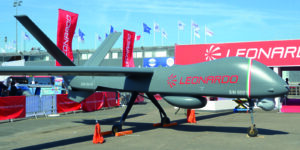
Despite its willingness to acquire relevant skills in UAV production in order to achieve strategic independence from Washington while filling ISR capability gaps and relaunching its defence industry, Europe is still lagging behind in class III models. Worse still, the need to recover from decades of poor spending and the preference for cooperation are widening the gap to other countries, particularly China and Turkey, which have started to produce effective UAV models in all segments and at limited cost. For them, export has no strings attached, so Chinese and Turkish products are easily conquering the African and Asian markets. So far, several European countries fly domestically developed, or at least European produced, tactical UAVs, and this trend seems to be confirmed for VTOL tactical UAVs and the development of miniaturised weapons. Consequently, European countries will probably be able to pick EU solutions to respond to their requirements.
However, the future is more uncertain when it comes to class III assets. As with the A400 ATLAS, European cooperation can slow down rather than promote joint solutions. The problems outlined for the MALE RPAS programme have already forced Germany to find gap-fillers, and launch a new lease of IAI HERON UAVs, to be redeployed in Afghanistan and Mali in the coming years. Greece, which was already using leased HERON models, made the same choice in May 2020.
As new REAPER systems are delivered to France, the main European countries are again looking abroad for their UAVs, despite the fact that the interest in these technologies has been reaffirmed by their inclusion in EU-funded programmes. Per these considerations, it is hard to envisage that Europe’s dependency on foreign MALEs and UCAVs will end soon.
Giulia Tilenni is an international affairs analys based in Paris, France.



